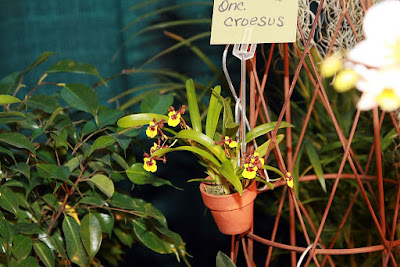This species is native to Brazil. The plants originally described as Oncidium croesus came from the coastal mountains near Rio de Janeiro and the nearby Organ mountains, at elevations of 400 to 600 meters. However, the amount of their natural environment is not given, so the temperatures given in the climate table and recommendations for cultivation should be treated with caution.
Oncidium croesus orchid, also called as The Rich Blooming Oncidium, is a species of the genus Oncidium. This species was first described by Heinrich Gustav Reichenbach in 1857. Several synonyms are know for this species such as: "Alatiglossum croesus ( Rchb.f. ) Baptista 2006"; "Gomesa croesus (Rchb.f.) M.W.Chase & N.H.Williams 2009"; "Kleberiella croesus (Rchb.f.) V.P.Castro & Cath. 2006"; "Oncidium longipes Hkr. non Lindley"; "Oncidium longipes var croesus [Rchb.f] Veitch 1892".
IDENTIFY ONCIDIUM CROESUS ORCHID
This species is native to Brazil. The plants originally described as Oncidium croesus came from the coastal mountains near Rio de Janeiro and the nearby Organ mountains, at elevations of 400 to 600 meters. However, the amount of their natural environment is not given, so the temperatures given in the climate table and recommendations for cultivation should be treated with caution.
It is a miniature sized, cool to warm growing epiphytic species, which can reach up to 18 cm in height, with clustered, ovate to oblong, laterally compressed pseudobulbs, which have 2.0-2.5 cm long, partially enveloped by several, imbricating, dry, scarious sheaths and carrying 1 or 2 apical, glossy green, slightly leathery, linear-oblong, conduplicate below into the base leaves, which are 10-15 cm long and 1.2 cm wide, that blooms in the spring and early summer on a few axillary, to 6" (15 cm) long, erect, zigzag inflorescence carrying 3 to 5, long-lasting, fragrant flowers.
The flowers are up to 4.5 cm in diameter, dark brownish-purple flakes of both whorls and a golden yellow lip, which has a brownish-purple to velvety-black border around the crestlike appendage. Stripe petals of the outer whorl have undulating edges and sharp tips. The dorsal petal is about 1 cm long and 0.4-0.5 cm wide. The side petals are about 1.5 cm long and 0.4-0.5 cm wide. The oblong, oblique petals of the inner whorl are 1 cm long and 0.5-0.6 cm wide. 3-flap lip is about 1 cm long and quite small, rounded side plots at the base and a large, broadly spread, kidney-shaped middle plot with a width of up to 1.7 cm, and a shallow depression in the center of the apical margin. A comb-like appendix, fleshy, with the shape of an elongated disk, is covered with numerous small protruding warts and has 2 distinct teeth at the front. The small rod has a pair of very narrow, almost residual wings at the apex.
GROW AND CARE ONCIDIUM CROESUS ORCHID
Light:
About 18000 - 25000 lux. It requires a medium bright position. The light should be filtered or diffused, and plants should never be exposed to direct sunlight. Strong air movement should be ensured all the time.
Temperature:
Oncidium croesus orchid is a plant with moderate thermal requirements. In summer the average day temperature is 23-25 ° C, at night 15-16 ° C, with a daily amplitude of 8-9 ° C. In winter, the average day temperature is 19-21 ° C, night 11 ° C, with a daily amplitude of 9 ° C.
Humidity:
There is no data on the location given, but probably the average humidity in these habitats is around 80% throughout the year.
Substrate and growing medium:
Although plants on rootstocks or in baskets usually grow better, they can also be grown in pots. If we grow them in pots, these must be relatively small, and the substrate very loose and airy, which at the same time retains some of the moisture without excessive soaking. Good results are achieved by using a medium medium sized tree fern fiber with approx. 10% perlite or pumice and 10% charcoal. In the case of plants grown in dry places, you can add an additional 10% of sphagnum moss. Use small pots so that only the roots fit and take place for about two years growth. The size of the pot and the type of substrate should be selected so that the cycle of 2-3 days wet / dry is possible during the growing season.
Watering:
In the period from late spring to autumn, rainfall is moderate to heavy. Plants in cultivation should be abundantly watered during active growth, with only slight drying between waterings. Some recommend 2-3 days drying between waterings in summer. When new growths reach maturity in the autumn, the amount of water should be gradually reduced. In winter, watering of cultivated plants should be limited, but must not be allowed to dry up too much or remain dry for a long time.
The easiest way to kill an orchid is by watering it too much. Excess humidity causes root rot and fungi proliferate in an uncontrolled manner. The best way to check whether the vessel is moist, is pressed with the finger the substrate. If it is still damp, do not water, wait until dry. Water until the water begins to flow under the substrate. Check moisture every 2 days.
Fertilizer:
During the active growth of the plants should be fertilized every week 1/4 - 1/2 of the recommended dose of fertilizer for orchids. Many growers prefer to use sustainable fertilizer throughout the year. Others use high-nitrogen fertilizer from spring to mid-summer, switching to high-phosphorus in late summer and autumn.
Fertilization should be reduced or completely eliminated until more intense watering starts in the spring.

















COMMENTS